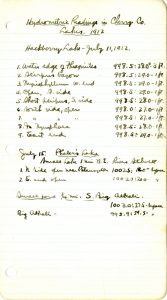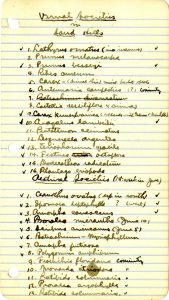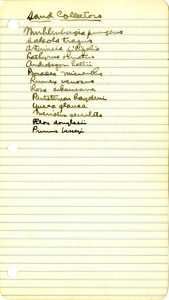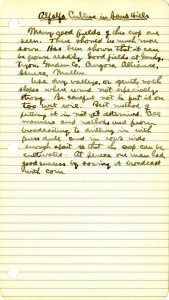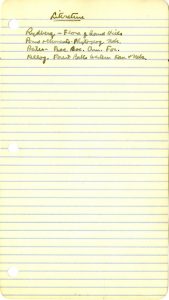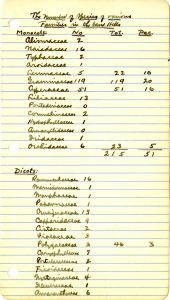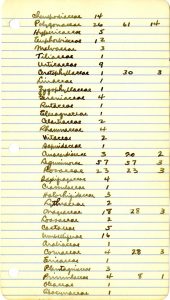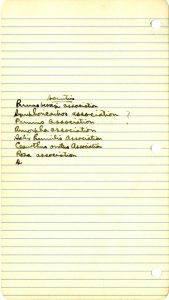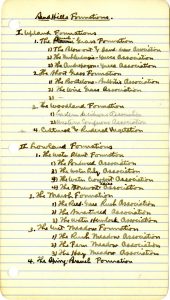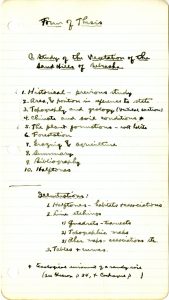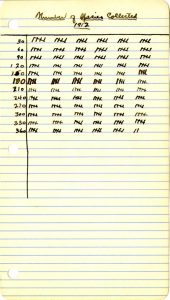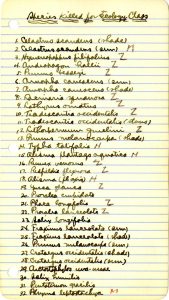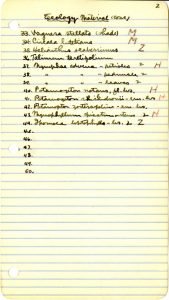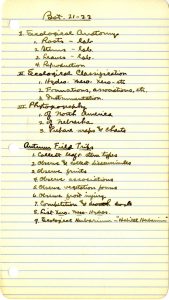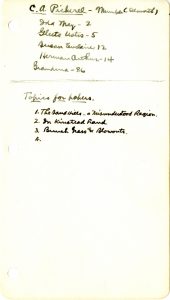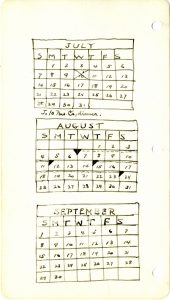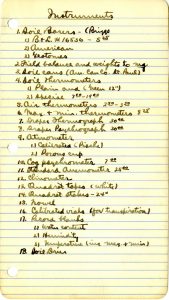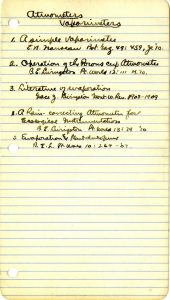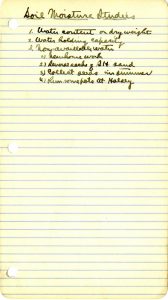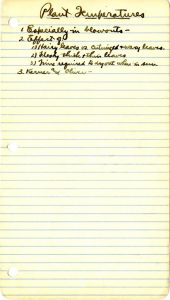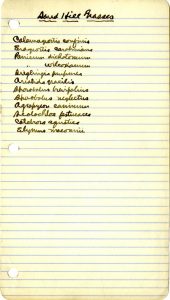Great Nebraska
Naturalists and ScientistsRaymond J. Pool, Notes, 1912, Part 4
”
Hydromatic Readings in Cherry Co. Lakes. 1912
Hackberry Lake — July 11, 1912
- 1. Water edge of Phragmites 998.5:28.0° — 3 ft.
- 2. Scirpus bayou 998.5:29.0 — 1 ft.
- 3. Myriophyllum W. end 998.5:29.0 — 1 ft.
- 4. Open, S. side 998.5:29.0 — 1 ft.
- 5. Short Scirpus, S. side 998.5:28.0 — 1 ft.
- 6. South side, open 998.0:27.0 — 1 ft.
- 7. ” ” ” 998.5:27.0 — 1 ft.
- 8. N. Nympahaea 998.5:28.0 — 1 ft.
- 9. East End 998.5:29.0 — 1 ft.
July 15Phalaris Lake Small Lake 1 mi. N.E. Rivers Stilwell
- 1. N. side open near Potamageton 10021.5:18.0 — surface
- 2. E. end open 1002.0:20.0 — “
Small Pond 1/4 mi. S. Big Alkali.
- 1003.0:27.5 — surface
- Big Alkali — 995.9:29.5—”
“
Visual Societies in Sand Hills
- 1. Lathyrus omatus (inc incanus)
- 2. Prunus melancarpa
- 3. Prunus besseyi
- 4. Ribes aureum
- 5. Carex — (Dismal River) moist pocket flats
- 6. Antennaria campestris (?) community
- 7.
Batrachium circinatum - 8. Castellia sessiliflora (Dismal)
- 9. Carex pennsylvanica (uplands — with Grasses & Muhlenbergia)
- 10. Arogalus lambertii
- 11. Penstemon acimatus
- 12. Lesquerella argentea
- 13. Eriophorum gracile
- 14. Festuca octoflora
- 15. Dodeoctheon readicatum
- 16. Plantago eriopoda
Aestival Societies (1st. week in June)
- 1. Ceanothus ovatus (esp. in South)
- 2. Ipomoea leptophylla? (west)
- 3. Amorpha canescens
- 4. Prosalea micrantha (June 10)
- 5. Scirpus americanus (June 5)
- 6. Batrachium — Myriophyllum
- 7. Amorpha fruticosa
- 8. Polygonum amphibium
- 9. Froelichia floridana community
- 10. Monarda citriodora “
- 11. Ratibida columnaris “
- 12. Psoralea argophylla “
- 13. Ratibida columnaris “
“
Rudbeckia hirta
“
Sand Collectors
- Muhlenbergia pungens
- Salsola tragus
- Artemsia filifolia
- Lathyrus omatus
- Andropogon hallii
- Psoralea micrantha
- Rumex vevosus
- Rosa arkansana
- Penstemon hayden
- Yucca glauca
- Meriolix serrulata
- Phlox douglasii
- Prunus besseyi
“
Sand Binders
- Redfieldia flexmosa
- Calamovilfa longifolia
- Eragrostis trichodes
- Psoralea micrantha
- Phaca longifolia
- Muhlenbergia pungens
- Penstemon haydeni
“
Alfalfa Culture in Sand Hills
Many good fields of this crop are seen. There should be much more sown. Has been shown
that it can be grown readily. Good fields at Gandy, Tryon, Garden Co. Angora, Alliance, Seneca, Mullen.
Use dry valleys, or gentle north slopes where wind not especially strong. Be careful
not to put it on too wet soil. Best method of putting it in not yet determined. All manners and methods used
from broadcasting to drilling in with press drill and in rows wide enought apart so
that the crop can be cultivated — At Seneca one man had good success by sowing it broadcast with corn.
“
Literature
-
Rydberg — Flora of Sand Hills
-
Pond elements— Phytogeog. Nebr.
-
Bates —Psoe. Soc. Am. For.
-
Kellog — Forest Belts between Kan. & Nebr.
“
The Number of Species of Various Families in the Sand Hills
| Monocots: | No | Tot. | Pec. |
| Alismaceae | 2 | ||
| Naiadaceae | 16 | ||
| Typhaceae | 2 | ||
| Aroidaceae | 1 | ||
| Lemnaceae | 5 | 22 | 10 |
| Graminaceae | 119 | 119 | 20 |
| Cyperaceae | 51 | 51 | 16 |
| Liliaceae | 13 | ||
| Pontedriaceae | 0 | ||
| Counclinaeae | 2 | ||
| Hydrophyllaceae | 1 | ||
| Amaryllidceae | 0 | ||
| Iridaceae | 1 | ||
| Orchidaceae | 6 | 23 | 5 |
| 215 | 51 |
| Dicots: | |||
| Ranunculaceae | 16 | ||
| Menispermaecea | 1 | ||
| Nympaceae | 1 | ||
| Papaveraceae | 1 | ||
| Cruciferaceae | 15 | ||
| Copparidaceae | 4 | ||
| Cistaceae | 2 | ||
| Violaceae | 3 | ||
| Polygalaecae | 3 | 46 | 3 |
| Caryophyllaceae | 7 | 0 | 0 |
| Portulacaceaceae | 2 | ||
| Ficoidaceae | 1 | ||
| Nystaqinaceae | 4 | ||
| Glecetraceae | 1 | ||
| Amaranthaceae | 6 |
“
| Chenepodiaceae | 14 | ||
| Polygonaceae | 26 | 61 | 14 |
| Hypericaceae | 5 | ||
| Euphorbiaceae | 12 | ||
| Malvaceae | 3 | ||
| Tiliaceae | 1 | ||
| Usticaeceae | 9 | ||
| Ceratophyllaceae | 1 | 30 | 3 |
| Linaceae | 1 | ||
| Zygophyllaceae | |||
| Geraniaceae | 4 | ||
| Rutaceae | 1 | ||
| Elaeaguaceae | 1 | ||
| Celartraceae | 2 | ||
| Rhammaceae | 4 | ||
| Vitaceae | 2 | ||
| Sapnidaceae | 1 | ||
| Anacardiaceae | 3 | 20 | 2 |
| Leguminorae | 57 | 57 | 2 |
| Rosaceae | 23 | 23 | 3 |
| Saxifragaceae | 4 | ||
| Cranulaceae | 1 | ||
| Haloshigidaceae | 3 | ||
| Lythraceae | 2 | ||
| Ongiaceae | 18 | 28 | 3 |
| Loasaceae | 2 | ||
| Cactaceae | 5 | ||
| Umbelliferae | 16 | ||
| Araliaceae | 1 | ||
| Cornaceae | 4 | 28 | 3 |
| Ericaeceae | 1 | ||
| Plantaginaceae | 3 | ||
| Prunuslaceae | 4 | 8 | 1 |
| Oleaceae | 1 | ||
| Apocynaceae | 1 |
“
| Asclepiadaceae | 13 | ||
| Gentianaceae | 4 | 19 | 3 |
| Polemouiaceae | 3 | ||
| Hydrophyllaceae | 1 | ||
| Boraguiaceae | 7 | ||
| Convolvulaceae | 7 | ||
| Solanaceae | 7 | 25 | 3 |
| Scrophulanaceae | 18 | ||
| Orobanchaceae | 2 | ||
| Lentibulanaceae | 1 | ||
| Pedaliaceae | 1 | 22 | 5 |
| Verbenaceae | 7 | ||
| Labiataceae | 20 | 27 | 5 |
| Caprifoliaceae | 3 | ||
| Rubiaceae | 7 | ||
| Campanulaceae | 9 | ||
| Ascusbitaceae | 2 | 21 | 5 |
| Compositae | 125 | 125 | 32 |
| 540 | 88 |
| Totals: | Moncots. | 215 | 51 |
| Dicots. | 540 | 88 | |
| 735 | 139 |
“
Societies
- Prunus besseyi assocciation
- Symphoricarpos association
- Prunus association
- Amorpha association
- Salix humilis association
- Ceanthus ovatus association
- Rosa association
- S
“
Sand Hills Formations.
I. Upland Formations
- 1. The Bunch — Grass Formation
- 1)The Blow-out and Sand-draw Association
- 2)The Muhlenbergia — Yucca Association
- 3) The Andropogon — Yucca Association
- 2. The Short Grass Formation
- 1) The Bouteloua — Bulbilis Association
- 2) The Wire Grass Association
- 3)
- 3. The Woodland Formation
- 1) Eastern Scriduous Association
- 2) Western Coniferous Association
- 4. Cultural and Ruderal Vegetation
II. Lowland Formations
- 1. The Water Plant Formation
- 1. The Pondweed Association
- 2. The Water Lily Association
- 3. The Water Crowfoot Association
- The Stonewaort — Naias asscociation
- 2. The Marsh Formation
- 1)the Reed — Grass Rush Associatoin
- 2) The Smartweed Association
- 3) The Water Hemlock Association
- 3. the Wet Meadow Formation
- 1)The Rush Meadow Association
- 2) The Fern Meadow Association
- 3) The Hay Meadow Association
- 4. The Spring — Branch Formation
“
Form of Thesis
A study of the Vegetation of the Sand Hills of Nebraska
- 1. Historical — previous study
- 2. Area, and position in reference to state
- 3. Topography and geology (vertical section)
- 4. Climate and soil conditions
- 5. The plant formations — root habits
- 6. Forestation
- 7. Grazing and agriculture
- 8. Summary
- 9. Bibliography
- 10. Halftones
Illustrations:
- 1. Halftones — habitats & associations
- 2. Line etchings
- 1) Quadrats — transects
- 2) Topographic maps
- 3) Other maps — associations etc.
- 3. Tables & curves
Ecological environment of a sanday soil (see Gleason p 34, & Cockayne p
”
Number of Species Collected 1912
1″
Species Killed for Ecology Class
- 1. Celastrus scandens (shade)
- 2. Celastrus scandens (sun)
- 3. Hymenopappus filifolius
- 4. Andropogon hallii
- 5. Prunus besseyi
- 6. Amorpha canescens (sun)
- 7. Amorpha canescens (shade)
- 8. Lacinaria squarrosa
- 9. Lathyrus ornatus
- 10. Tradescantia occidentalis
- 11. Tradescantia occidentalis (stems)
- 12. Lithospernum gruelini
- 13. Prunus melanocarpa (shade)
- 14. Typha latifolia
- 15. Alisma plantago aquatica
- 16. Rumex venosus
- 17. Redfieldia flexuosa
- 18. Alisma (fl. axis)
- 19. Yucca glauca
- 20. Psoralea cuspidata
- 21. Phaca longifolia
- 22. Psoralea lanceolata
- 23. Salix longifolia
- 24. Fraximus lanceolata (sun)
- 25. Fraximus lanceolata (shade)
- 25. Fraximus lanceolata(shade)
- 26. Prunus melanocarpa (sun)
- 27. Crataegus occidentalis (shade)
- 28. Crataegus occidentalis (sun)
- 29. Arctostaphylos uva-ursi
- 30. Salix hummilis
- 31. Penstemon gracilis
- 32. Phrysma leptostachya
2″
Ecology Material (cont)
- 33. Vagnera stellata (shade)
- 34. Circaea lutetiana
- 35. Helianthus scaperrimus
- 36. Talinum teretifolium
- 37. Nymphae advena — petioles
- 38. ” ” — peduncle
- 39. ” ” leaves
- 40. Potamogeton natans. fl. lvs.
- 41. Potamogeton richardsonii — em. lvs.
- 42. Potamogeton zosterafolius — em. lvs.
- 43. Myriophyllum spicatum — stems
- 44. thomaca leptophylla — – lvs. 2
- 45.
- 46.
- 47.
- 48.
- 49.
- 50.
“
Bot. 21 — 22
I. Ecological Anatomy
- 1.Roots
- 2. Stems — lab.
- 3. Leaves — lab.
- 4. Reproduction
II. Ecological Classification
- 1. Hydro — Nero — etc.
- 2. Formations, associations, etc.
- 3.Instrumentation
III. Phytogoraphy
- 1. Of North America
- 2. Of Nebraska
- 3. Prepare maps and charts
Autumn Field Trips
- 1. Collect leaf & stem types
- 2. Observe and collect disseminules
- 3. Observe fruits
- 4. Observe associations
- 5. Observe vegetation forms
- 6. Observe frost injury
- 7. Competition and drought
- 8. List Xero — Meso — Hydros
- 9. Ecological Herbarium — “Habitat Herbarium”
“
- C.A. Pickerel — Mumper (Ellsworth)
- Ida May — 2
- Gleeta Ustis — 5
- Susan Evelaine — 12
- Herman Arthur — 14
- Grandma — 86
Topics for papers
- 1. The Sand Hills — a Misunderstood Region
- 2. In Kinstead Land
- 3. Bunch Grass and Blowouts
- 4.
“
134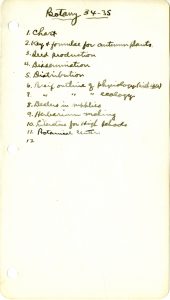
“
Botany 34-35
- 1. Chart
- 2. Key & formulae for autumn plants
- 3. Seed Production
- 4. Dissemination
- 5. Distribution
- 6. Brief outline of physiology (with epts)
- 7. ” ” ” ecology
- 8. Dealers in supplies
- 9. Herbarium making
- 10. Literature for High Schools
- 11. Botanical center
- 12.
“
Instruments
- 1. Soil Borers — (Briggs
- 1.) B. & L. #16536 — 525
- 2.) American
- 3.) Geotomes
- 2. Field balance and weights to mg.
- 3. Soil cans (Am. Can. co. St. Paul
- 4. Soil Thermometers
- 1.) Plain and (Green 12″)
- 2.) Special 700 — 1900
- 5. Air Thermometers 250 — 350
- 6. Max. & Min. thermometers 825
- 7. Draper Thermograph 3000
- 8. Draper Psychiograph 3000
- 9. Atmometer
- 1.) Calibrated (Pische)
- 2.) Porous cup
- 10. Cog psychometer 700
- 11. Standard Anemometer 2500
- 12. Clinometer
- 13. Quadrat tapes (white)
- 14. Quadrat stakes — 24″
- 15. shovel
- 16. Calibrated vials (for transpiration)
- 17. Record blanks
- 1.) Water blanks
- 2.) Humidity
- 3.) Temperature (size max. & min.)
- 18. Soil Drier
“
Adaptations
- 1.
Xerophytic adaptations of Apacynum hypericifolium
J.H. Schaffues
O. Nat.
10:184.
Jan ’10 - 2.
The realation of hairy and cutinized coverings to transpiration.K.M. WiegandBot. Gaz.49:430.Jun ’10.
“
Biological Factors
- 1.
Fire as a Biological FactorJ.C. BlumesPr. World13:42F. ’10
- 2.
An animal factor in Plant DistributionJ. C. BlumesPt. World13:16Jan ’10.
“
Arid Habitats Drought Resistance
- 1.
Physiologically arid habitats and drought resistance in Plants.A. DachmouskiBot. Gaz. 49:325M ’10.
“
Atmometers Vapaorimeters
-
1. A simple vaporimeter E.N. NauseauBot. Gaz.49:459,Je ’10
.
- 2.
Operation fo Porous cup AtmometerB.E. LivingstonPt. World 13:111M. ’10.
- 3.
Literature of evaporationGrace J. LivingstonMont. W. Rev. 1908-1909
- 4.
A Rain correcting Atmometer for Ecological InstrumentationB.E. LivingstonPt. World13:29’10.
- 5.
Evaporation and Plant DevelopmentR.E.L.Pt. World10:269—’07.
“
Instrument Dealers
- 1. Frederick Carl 631 G St. N.W. Washington
- 2. H.J. Green 1191 Bedford Ave. Brooklyn
- 3. Julien P. Iniez 107 E. German St. Baltimore
“
Plant temperatures — effect of leaf
modifications —
Kerver and Oliver
Nat. Hist. I:313
“
Soil Moisture Studies
- 1. Water content on dry weight
- 2. Water holding capacity
- 3. Non—available water
- 1.) Greenhouse work
- 2.) Several eachs of S. H. sand
- 3.) Collect seeds in summer
- 4.) Run some pots at Halsey
“
Plant Temperatures
- 1. Especially in blowouts —
- 2. Effect of:
- 1.) Hairy leaves vs. cutunized & wavey leaves.
- 2. Fleshy thick & thin leaves
- 3.) Time required to dry out when in sun.
- 3. Kerver and Oliver—
“
Sand Hill Grasses
- Calamagrostis confissis
- Eragrostis caroliniana
- Panicum dichatomum
- >Panicum wilcoxianum
- Sieglingia purpurea
- Aristada gracilis
- Sporobolus gracilis
- Sporobolus neglectus
- Agropyron caninum
- Scolochloa festucacea
- Catabrosa aquatica
- Elymus macounii
“
May 19
Left Gandy 80 M for the Dismal
“
Auto Faxes
| ’55— | 50% act. val 200— | 12.25 | |
| ’54 — | “ | 445— | 24.50 |
| ’52 | 965 | 11.86 | |
| ’51 | 1105 | 47.28 |
